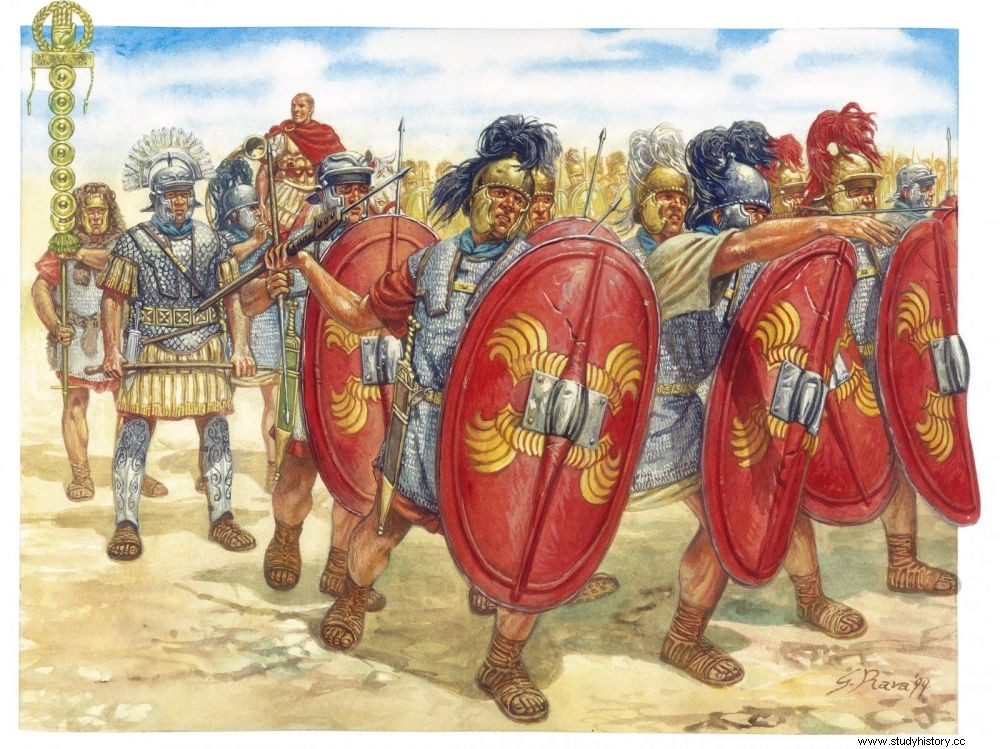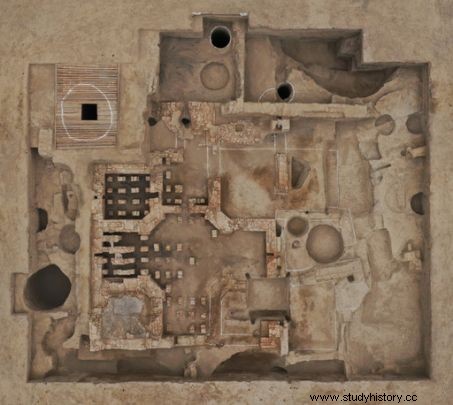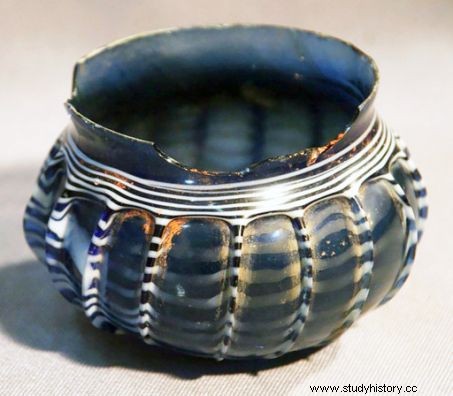Disturbing discoveries have multiplied in recent years in Asia. Public baths inspired by Roman baths, statuette of a warrior, fabrics, blown glass objects... Did the Romans go to the Middle Kingdom?

Roman Antiquity (Republic):a group of Roman legionaries - Illustration by Giuseppe Rava.
This article is from the magazine Sciences et Avenir - La Recherche n°889 dated March 2021.
The moment is solemn. In AD 166, two Westerners were introduced to the court of the Celestial Empire. They present themselves as ambassadors from Rome, the capital of an empire ruled at the time by Marcus Aurelius. They lay elephant tusks, rhinoceros horn and tortoiseshell at the feet of the Emperor of China - the "Son of Heaven" - who watches them, no doubt thinking that this is a diplomatic present, all in all quite modest, unrelated to the wealth of this very distant Rome of which he had been told. For a long time now, the Chinese sovereign has known that another great empire exists on the other side of the world. But are these men who call themselves envoys really official representatives? Looking at them, it seems to him more likely that they are Western merchants who must have encountered difficulties in their wanderings and usurped the title of emissaries of Rome to get by. Nevertheless:this meeting is historic.
The interest in this anecdote, meticulously described in the Hou Hanshu (Book of Later Han ), a chronicle compiled in the 5th century AD from documents dating back to the 2nd century AD, has just resurfaced on the shores of Lake Geneva. A team of Swiss-Chinese researchers has indeed been formed to explore these ancestral links. His goal ? Better understand the axis of commercial exchanges that could have existed in the Rome-China direction, much less known than the opposite axis called "silk roads", and the archaeological traces that could remain. Because the weakness of the Greek and Latin written sources on China, located more than 8000 kilometers east of Rome, responds in fact to the prolixity of the chronicles of the Middle Empire. They regularly refer to the Roman world (Da Qin ), while the Chinese state (called Thina in the Red Sea Journey written in Greek in Alexandria (Egypt) between the 1st and 3rd centuries AD) is rarely mentioned in Western sources.
A unique underfloor heating system
This article is from the magazine Sciences et Avenir - La Recherche n°889 dated March 2021.
The moment is solemn. In AD 166, two Westerners were introduced to the court of the Celestial Empire. They present themselves as ambassadors from Rome, the capital of an empire ruled at the time by Marcus Aurelius. They lay elephant tusks, rhinoceros horn and tortoiseshell at the feet of the Emperor of China - the "Son of Heaven" - who watches them, no doubt thinking that this is a diplomatic present, all in all quite modest, unrelated to the wealth of this very distant Rome of which he had been told. For a long time now, the Chinese sovereign has known that another great empire exists on the other side of the world. But are these men who call themselves envoys really official representatives? Looking at them, it seems to him more likely that they are Western merchants who must have encountered difficulties in their wanderings and usurped the title of emissaries of Rome to get by. Nevertheless:this meeting is historic.
The interest in this anecdote, meticulously described in the Hou Hanshu (Book of Later Han ), a chronicle compiled in the 5th century AD from documents dating back to the 2nd century AD, has just resurfaced on the shores of Lake Geneva. A team of Swiss-Chinese researchers has indeed been formed to explore these ancestral links. His goal ? Better understand the axis of commercial exchanges that could have existed in the Rome-China direction, much less known than the opposite axis called "silk roads", and the archaeological traces that could remain. Because the weakness of the Greek and Latin written sources on China, located more than 8000 kilometers east of Rome, responds in fact to the prolixity of the chronicles of the Middle Empire. They regularly refer to the Roman world (Da Qin ), while the Chinese state (called Thina in the Red Sea Journey written in Greek in Alexandria (Egypt) between the 1st and 3rd centuries AD) is rarely mentioned in Western sources.
A unique underfloor heating system
Lorenz Baumer, professor of classical archeology at the Department of Antiquity Sciences at the University of Geneva (Switzerland), has therefore recently made contact with his Chinese counterpart, Professor Jian Wei. Good pick ! The latter, who searched for fourteen years the city of Xanadu (Shangdu), in Inner Mongolia, the first capital of the Mongol Kublai Khan, had indeed made a surprising discovery. "We unearthed a Roman-style public bathhouse in Changji Hui Autonomous Prefecture, Xinjiang, a discovery unparalleled in China! explains to Sciences et Avenir the professor of archeology at the University of the People (Beijing). I have been interested for several years in the evidence of contacts that there may have been between the Roman Empire and the various Chinese dynasties. This discovery is fantastic." This bathhouse was unearthed during excavations carried out in the ancient city of Tangchaodun, in the Qitai district, in the northwest of Xinjiang province. "Even if these constructions were erected late, in the 10th century, they are undoubtedly part of the Romano-Byzantine architectural tradition, continues Jian Wei. The building, constructed of brick, has an underfloor heating system called a hypocaust (system used throughout the Roman Empire, editor's note) , a technique totally unknown in China." Evidence of the spread of Roman bathing culture to the foot of the Tian Shan Mountains, northwest of the Tarim Basin.
 Aerial view of the remains of the 10th-century baths in the ancient city of Tangchaodun. According to Chinese archaeologists, the building, previously unknown in China, was built on the principle of Roman baths, with an underfloor heating system called a hypocaust. Different rooms (hot and cold rooms) sharing the upper level. Credits:Prof. Jian Wei, People's University, Beijing.
Aerial view of the remains of the 10th-century baths in the ancient city of Tangchaodun. According to Chinese archaeologists, the building, previously unknown in China, was built on the principle of Roman baths, with an underfloor heating system called a hypocaust. Different rooms (hot and cold rooms) sharing the upper level. Credits:Prof. Jian Wei, People's University, Beijing.
For three years, Lorenz Baumer and Jian Wei have thus established a fruitful contact through the exchange of objects, photos, stratigraphic documents, or maps... So many proofs of these ancient West-East contacts, like this statuette 40 cm high bronze statue of a kneeling warrior dated to the 4th or 3rd century BC It was unearthed in Xinyuan district, western Xinjiang province. "The tunic and helmet as well as the posture of the figurine reflect Hellenistic and Roman models, unknown at the time in China" , explains Lorenz Baumer. The same goes for textiles. Already, when he was working in Palmyra (Syria), within the team of the German Institute, Lorenz Baumer had been dazzled by the discovery of a fragment of fabric from China. These vestiges confirmed that for a long time, the men and women of East and West exchanged fabulous textiles, and many other precious products. Thus this piece of woolen cloth unearthed in 1984 in tomb 1 of the necropolis of Sampula, in the province of Xinjiang, in northwestern China. "It shows the head and upper part of the body of a clearly Western man armed with a spear, with in the upper field, a centaur playing music" , details the specialist. Another testimony, a mirror representing a satyr and a maenad, exhumed in the necropolis of Noin-Ula in the province of Töv, in Mongolia. Not to mention the many objects in blown glass, a technique unknown in the Middle Kingdom until the end of the 6th century. “A nearly intact 1st century goblet, made in northern Italy, was found in Mongolia. And related glass fragments, also from the early Roman Empire, were discovered in the city of Hanjiang, in Jiangsu (east China, editor's note), in a tomb from the 1st century AD" , continues Lorenz Baumer.
 1st century goblet made in northern Italy and found in Inner Mongolia. Credits:AKG/Erdeneba Atar Dimaajav
1st century goblet made in northern Italy and found in Inner Mongolia. Credits:AKG/Erdeneba Atar Dimaajav
The "wool trees" described by Pliny the Elder
Roman and Byzantine coins also found their way to China. About a hundred pieces, mainly in gold, were collected, dated from the 4th to the 8th century. A silver-gilt plaque showing Dionysus riding a panther was also discovered near Jingyuan, Gansu province (northwest China) in 1988. "We also have a stele in Xi'an erected in January 781 which describes the first hundred and fifty years of the history of the arrival of the Nestorians (a branch of Eastern Christianity that appeared in the 5th century, editor's note) in China" , says Jian Wei.
This compilation work induces a real upheaval in the studies. Until then, only the importation of serum silks (from the country of the Seres, China) was amply described in the West. In the tombs of Palmyra, cited above, researchers have indeed found a remarkable number of silk fabrics from the Han period (206 BC / 220 AD), whose Chinese origin is indisputable because of the weaving technique and the representation of dragons or Chinese characters. One of the oldest pieces is a fragment of "han damask" from the 1st century BC, which was discovered in the funerary tower of Atenatan, in Palmyra. The Roman writer Pliny the Elder (23-79) describes in his Natural History "wool trees" from which the silk is said to have been woven tightly by the Chinese and then reeled and rewoven more loosely by Roman weavers. This method made it possible to multiply the profits, and was mocked in China, as the text of the Wei luë reveals wrote in 239-265 CE:"[The Romans] always made a profit by procuring the thick monochromatic silk fabrics in China, which they divided to produce silk fabrics with foreign designs […] Through such a variety of works, brought from such a distant world, it is possible to make the translucent matrons appear in public." From Horace to Martial, Roman poets evoke the finesse of silk that dresses the body of women without concealing anything.
A successful trade carried out by intermediaries
In the 3rd century, the use of silk will become general, men and women of high society adorning themselves with it. Silk will therefore be the symbol of indecent luxury and of the deliquescent man. "In Rome, spending on silk, which some considered immoral, drew sharp criticism" , recalls Lorenz Baumer. "According to the lowest estimate, India, the Seres and this peninsula (Arabia, editor's note) steal 100 million sesterces from our empire every year:that's what luxury and women are costing us!" , Pliny the Elder gets carried away. "Direct contacts between Rome and China were however limited because commercial and cultural exchanges were often carried out by third parties" , says Jian Wei. And for good reason. The Parthians, who derived their main wealth from the silk trade, always jealously ensured that the two empires did not come into direct contact in order to maintain their fruitful role as intermediaries. Not to mention that the regions crossed quickly became very dangerous during the invasions of the 5th -6th centuries (Huns, Mongols, etc.).
The study of relations between Rome and China is only in its infancy. Chinese specialists now come regularly to train in Europe to better understand the pieces of Roman antiquity so as to be able to identify them in the field. Research made difficult, however, by the fact that many excavation results in China are not accessible to Western researchers and are not the subject of publications. If the current Covid-19 pandemic has slowed down exchanges, they should resume as soon as possible, according to Lorenz Bau-mer, very enthusiastic about these initial results.
The invention of a tradition
A quite astonishing legend is firmly established in the current province of Gansu (China). Known as the "legend of the Romans of Liqian", it would be attributed to a certain Marcus Licinius Crassus. This story, which actually finds its origin in the book of the British Homer Hasenpflug Dubs in A Roman City in Ancient China (1957). He tells there that Roman legionnaires captured by the Parthians during the battle of Carrhes, in 53 BC, would have been deported to the Far East. Although no proof has ever been provided, the tradition is so strong that the inhabitants of the ancient region of Liqian have been organizing performances for a few years. They then carry a javelin (pilum ), sword, helmet (galae ), shield and tunic and engage in battles of "Roman legionaries". The innovative research carried out by the Swiss researcher Lorenz Baumer and his Chinese counterpart Jian Wei on the relations between the Roman Empire and China is experiencing growing enthusiasm locally, and more broadly among the Chinese public accustomed to hearing tales for centuries. relating thereto.
